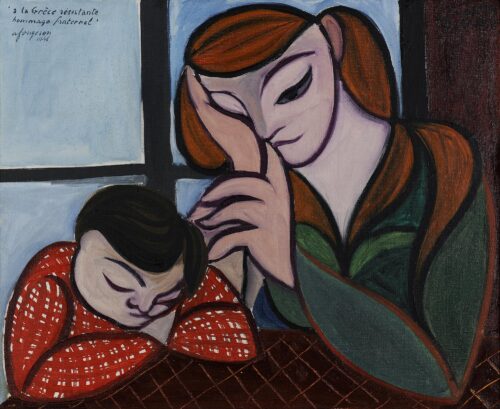
Fougeron Andre (1913 - 1998)
Mother and Child in Red Uniform, 1944
He was a self-taught painter. He worked as a metal worker for Renault Enterprises. In 1939 he became a member of the Communist Party and during the German occupation was very active in the Resistance. In 1941 he turned his studio into an illegal printing shop where he designed the titles for illegal newspapers as well as printing most them. The same year he presented his work in the exhibition “Vingt Peintres des traditions francaise”.
In 1942 he was put in charge of art matters for the National Front of the Arts and worked together with Edouard Pignon and Edouard Goerg. The following year he participated in the exhibition “Douze peinters d’ aujourd’ hui”, which played a definitive role in the creation of a new School of Paris. The group would be named New French Realists.
In 1944 he met Pierre Villon and Paul Eluard. After the Liberation, he was assigned the organization of an exhibition of Picasso’s works, by then a symbol of the resistance against the German occupation. He presented the work “la Guerre” and later, after steps were taken by the National Front, it was purchased by the state. In 1947 he took a journey to Italy for many months where he studied Italian painting and met Italian artists.
His first solo exhibition was in 1946 and this was followed by a great deal of exhibition activity. He decorated the church at Romainville and did other public buildings as well. He won many prizes. In 1954 he was invited to the Venice Biennale for his lithographs.
His subject matter always was involved with social and political criticism and his works were commentaries on the major events of his era.

Mother and Child in Red Uniform, 1944

We use cookies to make our site work properly, to personalize content and ads, to provide social media features and to analyze our traffic. We also share information about how you use our site with our social media, advertising and analytics partners. Read the Cookies Policy.
These cookies are necessary for the website to function and cannot be switched off in our systems. They are usually only set in response to actions made by you which amount to a request for services, such as setting your privacy preferences, logging in or filling in forms. You can set your browser to block or alert you about these cookies, but some parts of the site will not then work. These cookies do not store any personally identifiable information.
If you disable this cookie, we will not be able to save your preferences. This means that every time you visit this website you will need to enable or disable cookies again.
These cookies tell us about how you use the site and they help us to make it better. For example these cookies count the number of visitors to our website and see how visitors move around when they are using it. This helps us to improve the way our site works, for example, by ensuring that users find what they are looking for easily. Our website uses Google Analytics for statistics reporting.
Please enable Strictly Necessary Cookies first so that we can save your preferences!